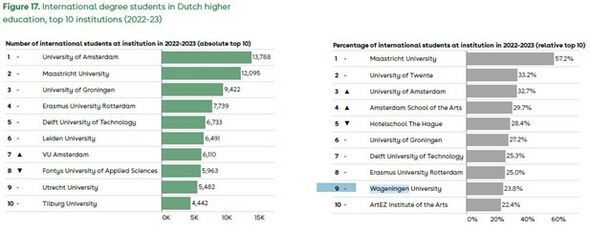Growth in international students almost halved
The number of foreign students in higher education in the Netherlands this academic year rose by 7 percent, a lot less than in previous years. The reasons for that include the basic student grant, Brexit and the war in Ukraine. At TU/e, however, there is still a sharp increase in the number of internationals. Compared to the previous 2021-2022 academic year, that increase is 26 percent.
More than 122,000 foreign students are in full-time education in the Netherlands. That is 7 percent more than last year, according to new research by Nuffic, the Dutch organisation for internationalisation in education. It breaks with the trend of previous years. In the last academic year, the growth percentage was 12 percent.
One of the reasons given by Nuffic is that, just like Dutch students, some internationals prefer to start their studies next year, so they can make use of the new basic student grant.
However, the figures in the BI Portal of the TU/e (only accessible via intranet) show quite different figures for the Eindhoven intake of international students. For this academic year, 3161 internationals are listed, compared to 2511 last academic year. That means an increase of 26 percent. And that percentage increase is again higher if the 2020-2021 and 2021-2022 college years are compared. Then there was a 22 percent increase, in absolute numbers: from 2049 it rose to 2511 foreign students. From the 2020-2021 academic year, the proportion of students from the European Economic Area (EEA) also began to outpace the intake from outside Europe. For this current academic year, that distribution is: 1851 EEA students and 1310 non-EEA.
Brexit and the Ukraine war
According to the report, Brexit makes it less attractive for British students to study in the Netherlands. This academic year more than 1,800 British are studying in the Netherlands, 42 percent fewer than before the UK left the European Union. The United Kingdom used to be among the top ten, but has now fallen to 17th place.
Other developments play a role as well. The Russian invasion of Ukraine, for instance, led to a rise in the number of Ukrainian students in the Netherlands. There are now 1,059, which is 47 percent more than in 2021-22.
Top five
The largest group of foreign students in Dutch higher education is still from Germany. Italy is again in second place, followed by China and Romania. A newcomer in the top five is Spain, replacing Belgium.
One in seven of all the students in higher education is from abroad. They come from 167 different countries and a quarter of them are from the European Economic Area. The latter group does not include the UK and Switzerland, for example.
Around 85,000 international students are currently attending a research university and nearly 37,000 are studying at a university of applied sciences.
Popular
At university of applied sciences, study programmes in the field of economics attract the most foreign students. Percentage-wise the field of Language and Culture draws the highest number. At the research universities, study programmes in the Behavioural & Social Sciences sector are the most popular. In relative terms, however, the university colleges have the biggest percentage of international students.
At TU/e, the Mathematics and Computer Science program is unchallenged leader with a total of 1024 internationals. Far behind are Electrical Engineering and Mechanical Engineering with 494 and 459 foreign students, respectively.
In absolute terms, the University of Amsterdam has the largest number of international students. The only university of applied sciences in the top ten is Fontys. But Maastricht University heads the list in relative terms: more than half of the university’s student body comes from abroad. Only the study programmes with 2,000 students or more have been included in the top ten in terms of relative numbers.
At the smaller institutions, the arts programmes have the largest number of international students. At the Design Academy in Eindhoven almost 80 percent of the students come from abroad; the figure at the University of the Arts in The Hague is 67 percent and at the Gerrit Rietveld Academy in Amsterdam 65 percent.
More control
The influx of international students is no longer being encouraged in political circles. Education Minister Robbert Dijkgraaf is putting forward new legislation that aims to channel the influx of international students. He wants more central control and would like foreign students to learn some Dutch.
The number of international students has doubled in the past two decades. Critics warn of overcrowded lecture halls, a high workload among teaching staff, a lack of accommodation, a steady decline in the accessibility of study programmes and the demise of Dutch as an academic language.



Discussion